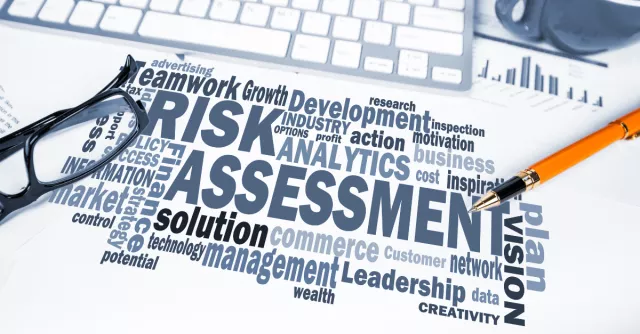How to Perform a Risk Assessment

In this blog post, we'll cover why businesses need to perform a risk assessment, regulatory concerns to be aware of, a step-by-step guide to performing a risk assessment, tips for maximizing efficiency and effectiveness, and the benefits of proactively managing risk. Read on to learn more about how to perform a risk assessment.
Why Businesses Need to Perform a Risk Assessment
Businesses need to perform a risk assessment to identify, assess, and manage potential risks that could have an impact on their operations. Risk assessments are important for businesses of all sizes and across all industries. They help organizations identify areas of vulnerability, anticipate potential problems, and take steps to eliminate or reduce the chances of them occurring. With the right approach, risk assessments can also provide businesses with valuable insight into how they can better manage their operations and achieve long-term success.
Risk assessments are not just about avoiding losses — they can also offer a range of advantages for organizations. For example, a comprehensive risk assessment examines all aspects of an organization’s operations, including compliance with laws and regulations, safety measures, and personnel policies. By identifying any gaps in these areas, businesses can make changes that may lead to greater efficiency and cost savings over time.
A well-crafted risk assessment strategy is also key to helping organizations prepare for challenging times ahead by anticipating potential threats before they become reality. This helps businesses stay one step ahead in an increasingly complex business environment where change is often rapid and unexpected events can significantly impact day-to-day operations. Additionally, a proactive approach to managing risks means that companies are better prepared to respond quickly without compromising their objectives or reputation when challenges arise - such as natural disasters or economic downturns.
Finally, performing regular risk assessments helps ensure that businesses remain compliant with applicable laws and regulations while maintaining the highest safety, security, and data protection standards. Not only does this help protect individuals associated with the organization, but it is also essential for avoiding costly fines or legal action from regulatory bodies should any issues arise down the line.
Overall, performing regular risk assessments is essential for organizations looking to maintain their competitive edge in today's ever-evolving business landscape while minimizing their exposure to risks at the same time. By taking the necessary steps now to assess potential threats before they become a reality, companies can build resilience into their operations while safeguarding both their people and profits in the long run.
Regulatory Concerns to Be Aware of
When performing a risk assessment, it is important to be aware of any regulatory concerns that may apply. In many countries and jurisdictions, organizations must meet certain standards to comply with the law. Depending on your industry, there could also be specific regulations related to your operations.
In some cases, regulations require organizations to conduct regular risk assessments, which should include assessing department- and location-specific threats. The results of these assessments should then be used to improve processes and procedures in order to reduce potential risks.
It’s also important for organizations to review their existing policies and procedures regularly to ensure they are meeting all applicable regulations. This helps ensure that the business operates within legal parameters and can help protect against potential liabilities down the line.
In addition, organizations should stay up to date on changes in laws or regulations that may impact their operations. It’s crucial for businesses of all sizes to follow current laws and anticipate any future changes that could affect them from a risk perspective.
Being aware of regulatory concerns can help an organization prepare for a successful risk assessment process and proactively mitigate potential risks before they arise. By understanding and closely following relevant laws, organizations can minimize liability while protecting their employees and customers.
Step-by-Step Guide to Performing a Risk Assessment
When it comes to performing a risk assessment, a few key steps should be taken.
Identify the Risks
The first step is to identify the risks. This involves understanding the potential threats to the organization, such as natural disasters, cyberattacks, or internal issues like employee theft. Once identified, these risks should be assessed for potential severity and probability of occurrence. This allows organizations to prioritize their risk management efforts and assign resources accordingly.
Develop an Effective Response Plan
The second step is to develop an effective response plan. This involves determining which risks must be addressed and what actions must be taken for the organization to effectively respond if the risk materializes. Depending on the type of risk involved, this could include developing prevention measures such as employee training programs or insurance policies, preparing contingency plans, or establishing procedures for reporting incidents and data breaches.
Implement the Response Plan
The third step is the implementation of the response plan. Organizations should ensure that their employees are properly trained and informed about their roles in responding to any risks that may materialize. Additionally, they should establish processes for monitoring activities and implementing corrective measures when necessary in order to maintain compliance with applicable laws and regulations.
Evaluate the Response Plan
Finally, organizations should evaluate their response plans regularly to ensure they remain effective over time. This includes making sure that all relevant personnel are kept up to date on changes in laws or regulations that could affect their operations from a risk perspective as well as actively addressing any new threats that arise to minimize liability and protect employees and customers alike.
Tips for Maximizing Efficiency and Effectiveness
Efficiency and effectiveness are key to risk assessments. Here are some tips for maximizing both:
Start at the Source
When performing a risk assessment, it’s important to start at the source of the risk and work your way out from there. Identify all potential areas that could be impacted by a particular risk and look for ways to mitigate or eliminate them. This will help you understand the full scope of the risk and create an effective response plan.
Make Use of Existing Resources
Organizations should take advantage of existing resources, such as industry standards and best practices, when assessing risks and designing response plans. Doing so can help save time and money while streamlining the process overall.
Keep an Open Dialog with Stakeholders
Risk assessments involve multiple stakeholders who must be kept informed throughout the process in order to ensure its success. Maintain an open dialog between all parties involved to maximize efficiency and effectiveness while minimizing errors or oversights that could lead to costly mistakes down the line.
Utilize Technology Whenever Possible
Technology can make life easier when performing a risk assessment, from automated tools for data collection to sophisticated analytics software for analyzing results. Utilizing these tools can save time, increase accuracy, and provide more comprehensive insights into potential areas of concern — all of which help create more effective response plans that are tailored specifically to your organization’s needs.
Focus on Communication Throughout the Process
Communication is another key factor when it comes to risk assessments; without proper communication between all involved parties, there is always a chance that something could be overlooked or miscommunicated, which could lead to costly errors down the line. Be sure everyone involved has access to updated information on any changes or developments related to the assessment in order to ensure maximum efficiency and effectiveness throughout every step of the process.
Benefits of Proactively Managing Risk
Proactively managing risk can bring significant benefits to any organization. The most obvious benefit is the reduction of potential losses from unexpected events or hazards. By recognizing and responding to risks, organizations can often avoid costly mistakes and save money in the long term. Additionally, proactive risk management may help improve overall safety and security.
Furthermore, proactively managing risk can also help increase efficiency and effectiveness by focusing resources on the areas that need them the most. It can help prioritize tasks based on their potential impact, allowing organizations to use their time and resources better. Moreover, actively monitoring risks helps identify areas for improvement more precisely than relying on intuition or experience alone.
Finally, having a formalized process for assessing risk gives an organization a competitive advantage over those without one. A thorough understanding of internal and external risks can give businesses the edge they need to stay ahead of the curve in today’s fast-paced business environment. Proactive risk management also demonstrates an organization’s commitment to safety and compliance, which can enhance its public image and credibility with stakeholders such as investors or customers.
Curious to learn more about integrating your risk assessment and analysis directly alongside your business continuity plan? Check out our webinar "Powerful Ways to Update Your Company's Risk Analysis and Assessment", here.


